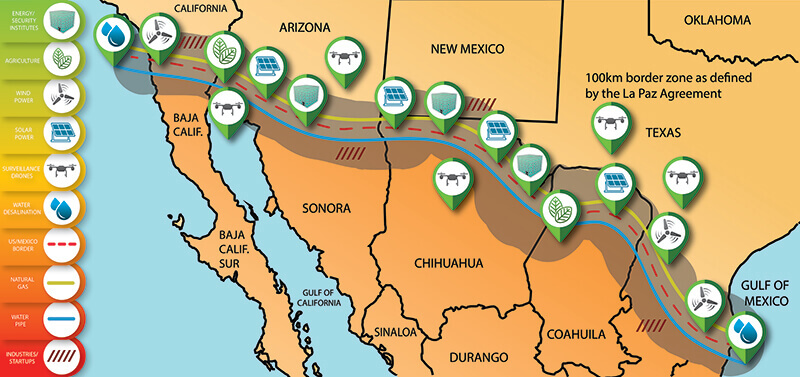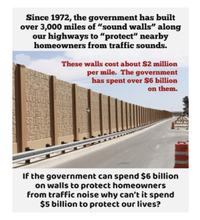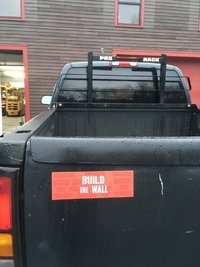-
If you enjoy the forum please consider supporting it by signing up for a NES Membership The benefits pay for the membership many times over.
You are using an out of date browser. It may not display this or other websites correctly.
You should upgrade or use an alternative browser.
You should upgrade or use an alternative browser.
The wall????
- Thread starter joseph
- Start date
Need a cite. This article gives a figure of $30.78 per square foot, or roughly $162k per mile. Works out to less than $500 million on the wall over 46 years or about $10 million a year.
$30.78 * 5280 feet = $162,518.40 per mile.
View: https://medium.com/re-form/muting-the-freeway-e18ee195bd38
"According to the Federal Highway Administration, the average cost of building a sound wall is $30.78 per square foot"
$30.78 * 5280 feet = $162,518.40 per mile.
View: https://medium.com/re-form/muting-the-freeway-e18ee195bd38
SpaceCritter
NES Member
Need a cite. This article gives a figure of $30.78 per square foot, or roughly $162k per mile. Works out to less than $500 million on the wall over 46 years or about $10 million a year.
$30.78 * 5280 feet = $162,518.40 per mile.
That's linear feet.
Need a cite. This article gives a figure of $30.78 per square foot, or roughly $162k per mile. Works out to less than $500 million on the wall over 46 years or about $10 million a year.
$30.78 * 5280 feet = $162,518.40 per mile.
View: https://medium.com/re-form/muting-the-freeway-e18ee195bd38
$30.78 x 5,280’ x (13'= avg height of wall) = $2,112,740 per mile
$2,1 12,740 x 3,000 mi = $6,338,217,600 roughly
Last edited:
$30.78 x 5,280’ x (13'= avg height of wall) = $2,112,740 per mile
$2,1 12,740 x 3,000 mi = $6,338,217,600 roughly
I stand corrected. At least we have our cite now. Thanks.That's linear feet.
The 5 billion is only for 234 miles of wall.
Highway sound barriers don't have to cross the Rio Grande or withstand it's flooding.
The wall needs to have openings for wildlife migration. People will also use it for migration.
There are lot of complications with private farmland and it's proximity to the border and the river. US farmers need to access parts of their land that is north of the river but south of the wall. I would assume that they also need to access the river itself for irrigation system pumps.
The wall is a lot more complicated that some folks realize and actual costs have been estimated to be closer to 50 billion.
Highway sound barriers don't have to cross the Rio Grande or withstand it's flooding.
The wall needs to have openings for wildlife migration. People will also use it for migration.
There are lot of complications with private farmland and it's proximity to the border and the river. US farmers need to access parts of their land that is north of the river but south of the wall. I would assume that they also need to access the river itself for irrigation system pumps.
The wall is a lot more complicated that some folks realize and actual costs have been estimated to be closer to 50 billion.
The 5 billion is only for 234 miles of wall.
Highway sound barriers don't have to cross the Rio Grande or withstand it's flooding.
The wall needs to have openings for wildlife migration. People will also use it for migration.
There are lot of complications with private farmland and it's proximity to the border and the river. US farmers need to access parts of their land that is north of the river but south of the wall. I would assume that they also need to access the river itself for irrigation system pumps.
The wall is a lot more complicated that some folks realize and actual costs have been estimated to be closer to 50 billion.
Perfect, that happens to be our foreign aid budget. We can put it towards the wall instead.
Dennis in MA
NES Member
- Joined
- Feb 12, 2007
- Messages
- 38,231
- Likes
- 33,152
The 5 billion is only for 234 miles of wall.
Highway sound barriers don't have to cross the Rio Grande or withstand it's flooding.
The wall needs to have openings for wildlife migration. People will also use it for migration.
There are lot of complications with private farmland and it's proximity to the border and the river. US farmers need to access parts of their land that is north of the river but south of the wall. I would assume that they also need to access the river itself for irrigation system pumps.
The wall is a lot more complicated that some folks realize and actual costs have been estimated to be closer to 50 billion.
Not to be overly technical, but you only have to "cross" the Rio Grande with a wall in one place - El Paso - where it finally goes INTO the United States. The rest of the time, it's the BORDER delineation. I'm betting there's already a wall in El Paso over the RG.
The current wall in El Paso crosses the Rio Grande at a 90 degree angle so it resembles a dam.
I wasn't clear in my last sentence. I was just trying to answer the question posed in the original post and explain why it's not as simple as just installing highway barriers or similar types of wall. There is lots of stuff in the way on the US side of the Rio Grande such as private property, farmland, parks and even whole towns. The wall might have to cross the river and jump over to the Mexican side of the border to skirt around stuff and then jump back to the US side after the obstacle has been cleared. There is also a 120 year old treaty regarding water access rights, not interfering with the natural flow (and flooding) of the river, wildlife access to the river, etc. Currently there are sections of wall that bisect private property and the landowners actually have a gate in the wall with an electronic passcode so they can access their property on the south side. There is also a lot of NIMBY stuff and there's a history of folks getting burned on government payouts in eminent domain situations. It would be a very expensive engineering and political feat to make it all work.
I wasn't clear in my last sentence. I was just trying to answer the question posed in the original post and explain why it's not as simple as just installing highway barriers or similar types of wall. There is lots of stuff in the way on the US side of the Rio Grande such as private property, farmland, parks and even whole towns. The wall might have to cross the river and jump over to the Mexican side of the border to skirt around stuff and then jump back to the US side after the obstacle has been cleared. There is also a 120 year old treaty regarding water access rights, not interfering with the natural flow (and flooding) of the river, wildlife access to the river, etc. Currently there are sections of wall that bisect private property and the landowners actually have a gate in the wall with an electronic passcode so they can access their property on the south side. There is also a lot of NIMBY stuff and there's a history of folks getting burned on government payouts in eminent domain situations. It would be a very expensive engineering and political feat to make it all work.
StevieP
NES Member
Need a cite. This article gives a figure of $30.78 per square foot, or roughly $162k per mile. Works out to less than $500 million on the wall over 46 years or about $10 million a year.
$30.78 * 5280 feet = $162,518.40 per mile.
View: https://medium.com/re-form/muting-the-freeway-e18ee195bd38
That works if you want a one-foot tall wall.
Dennis in MA
NES Member
- Joined
- Feb 12, 2007
- Messages
- 38,231
- Likes
- 33,152
The current wall in El Paso crosses the Rio Grande at a 90 degree angle so it resembles a dam.
I wasn't clear in my last sentence. I was just trying to answer the question posed in the original post and explain why it's not as simple as just installing highway barriers or similar types of wall. There is lots of stuff in the way on the US side of the Rio Grande such as private property, farmland, parks and even whole towns. The wall might have to cross the river and jump over to the Mexican side of the border to skirt around stuff and then jump back to the US side after the obstacle has been cleared. There is also a 120 year old treaty regarding water access rights, not interfering with the natural flow (and flooding) of the river, wildlife access to the river, etc. Currently there are sections of wall that bisect private property and the landowners actually have a gate in the wall with an electronic passcode so they can access their property on the south side. There is also a lot of NIMBY stuff and there's a history of folks getting burned on government payouts in eminent domain situations. It would be a very expensive engineering and political feat to make it all work.
Hey - I was just nit-picking. LOL
I'm betting a LOT of the areas that are near towns and have issues already HAVE a wall or a big-ass fence or something. Just like El Paso and other border towns. So the net effect is somewhere between my simpleton "there is no problem" and your very observant "lots of problems."
The biggest question is what do you do with Amistad??? THAT'S a border tactical nightmare.
Dennis in MA
NES Member
- Joined
- Feb 12, 2007
- Messages
- 38,231
- Likes
- 33,152
You notice that the libs are marching for their P-cats. They march for the ASSTAGblm. Are they marching for illegals?? Hmmmm. No.
ridleyman
NES Member
$30.78 x 5,280’ x (13'= avg height of wall) = $2,112,740 per mile
$2,1 12,740 x 3,000 mi = $6,338,217,600 roughly
A bargain, if you compare it with the alternative financial and social expenses of not having a wall. However, the Republicans should do more to woo Latinos into their fold. Unlike leftist Democrats who have usurped the demon party, Latinos are faithful religious folks, have more traditional family values, many Latino men like guns, and they're not afraid of their own masculinity.
falcon123
NES Member
The 5 billion is only for 234 miles of wall.
Highway sound barriers don't have to cross the Rio Grande or withstand it's flooding.
The wall needs to have openings for wildlife migration. People will also use it for migration.
There are lot of complications with private farmland and it's proximity to the border and the river. US farmers need to access parts of their land that is north of the river but south of the wall. I would assume that they also need to access the river itself for irrigation system pumps.
The wall is a lot more complicated that some folks realize and actual costs have been estimated to be closer to 50 billion.
Let's pretend that it's another big dig. Start with the $1.3 billion authorized and keep going adding funding as needed. As John Kerry once said about the big dig, "it will be a bargain."
What if a border wall could pay for itself? - Purdue University News

1,954-mile ‘energy park’ would pay for border wall, create economic boom

A bold new plan proposes that the United States and Mexico jointly build a 1,954-mile energy park along the border instead of a wall. The proposal, by 28 prominent U.S. scientists and engineers, says that the effort would bring abundant energy and water to the region while also providing border security and economic stability.
1,954-mile ‘energy park’ would pay for border wall, create economic boom
- Joined
- Aug 12, 2014
- Messages
- 9,378
- Likes
- 8,973
The 5 billion is only for 234 miles of wall.
Highway sound barriers don't have to cross the Rio Grande or withstand it's flooding.
The wall needs to have openings for wildlife migration. People will also use it for migration.
There are lot of complications with private farmland and it's proximity to the border and the river. US farmers need to access parts of their land that is north of the river but south of the wall. I would assume that they also need to access the river itself for irrigation system pumps.
The wall is a lot more complicated that some folks realize and actual costs have been estimated to be closer to 50 billion.
Sounds like excuses..... Mexico can keep all their animals as far as I’m concerned.
Share:
Similar threads
- Replies
- 6
- Views
- 481
- Replies
- 4
- Views
- 240







